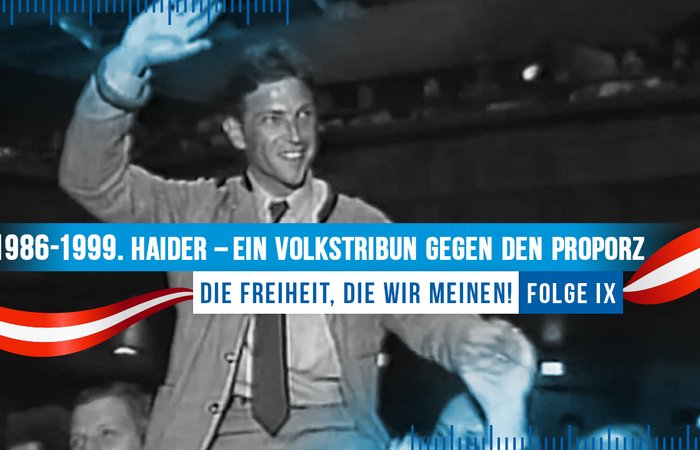The History of the FPÖ: Part 9
1986 - 1999. Haider – A People’s Tribune against the red-black (SPÖ-ÖVP) Proporz
We have just published Part 9 of our documentary series on the history of the national-liberal Lager and the FPÖ. Watch the film "1986 - 1999. Haider – A People’s Tribune against the red-black (SPÖ-ÖVP) Proporz":
LINK to Youtube 1986-1999. Haider - a People’s Tribune against the red-black (SPÖ-ÖVP) Proporz
The Freedom Party of Austria came into being on 7 April 1956 at a founding party conference. In its name it bears the word "Freiheit" (freedom), which is considered a core element of its programme. However, the roots of this national-liberal community of shared beliefs go back to the early 19th century. In our new series we illuminate the history of the national-liberal Lager and the FPÖ:
Part 9: "1986 - 1999. Haider – A People’s Tribune against the red-black Proporz":
The development of the FPÖ under the leadership of Jörg Haider is considered one of the most exciting episodes in the history of the Second Republic, since the rise of the native Upper Austrian led to the first fundamental change since 1945 in the domestic party landscape. Besides, the 14-year period between 1986, when Haider was elected FPÖ Chairman at the contested Innsbruck vote against Norbert Steger and the black-blue government in 2000, saw a string of successes.
The trained lawyer, who had in 1979 already entered the National Council as an FPÖ Member of Parliament and in 1983 took over the leadership of the Carinthian Freedom Party, was also able to reintegrate the national camp into the FPÖ and broadened the party both in terms of policy and personnel.
As a consequence of Haider’s election, SPÖ Chancellor Franz Vranitzky terminated the “Small Coalition” with the FPÖ, which had existed since 1983. At the resulting new elections in November 1986, the FPÖ under Jörg Haider received about 9.7 percent of the votes. The SPÖ and ÖVP reacted to the sudden strength of the Third Lager with a reconstituted Grand Coalition government and an ongoing political and media marginalisation of the FPÖ. This gave Haider even more opportunity to denounce the manner in which the SPÖ and ÖVP provided economic privileges for their members and partisans and to position the FPÖ in the National Council as an opposition party against this “red-black system". Haider thus became the political motor of change in a country where politics had until then still been determined by the Lager mentality of the post-war period.
Carinthia became the trailblazer of the transformation of the Austrian political system. There, Haider was in 1989 able to break the absolute majority of the SPÖ and with the help of the ÖVP was elected the first FPÖ Provincial Governor of the Second Republic. At the 1999 provincial elections, the FPÖ became the party with the largest number of votes and Haider was again appointed Governor.
But the FPÖ also achieved considerable successes in federal elections and these were scarcely affected even by the 1993 breaking away from the FPÖ of the Liberal Forum. After obtaining 22.5 percent in the 1994 National Council election, Haider achieved a historic result with the FPÖ in the 1999 election to the National Council: with 26.9 percent of the vote, the Freedom Party ousted the ÖVP from second place. Together with ÖVP Chairman Wolfgang Schüssel, Haider agreed a black-blue coalition, to which he himself did not belong, however, and in which Schüssel became Federal Chancellor. Susanne Riess-Passer joined the government as FPÖ Vice-Chancellor.
Even though Jörg Haider's political path after 2000 was marked by a number of fault lines - even with his former party - many political observers, contemporary witnesses and also former opponents acknowledge Jörg Haider's achievements in the fight against the red-black Proporz and the excesses of the neo-corporatist “chamber state”, as well as the deregulation of the quasi-state sector triggered by this. And last but not least, with the 1993 FPÖ referendum "Austria First" on migration policy, Haider for the first time clearly highlighted a topic that almost 30 years later has reached the centre of society and is exercising the whole of Europe.
